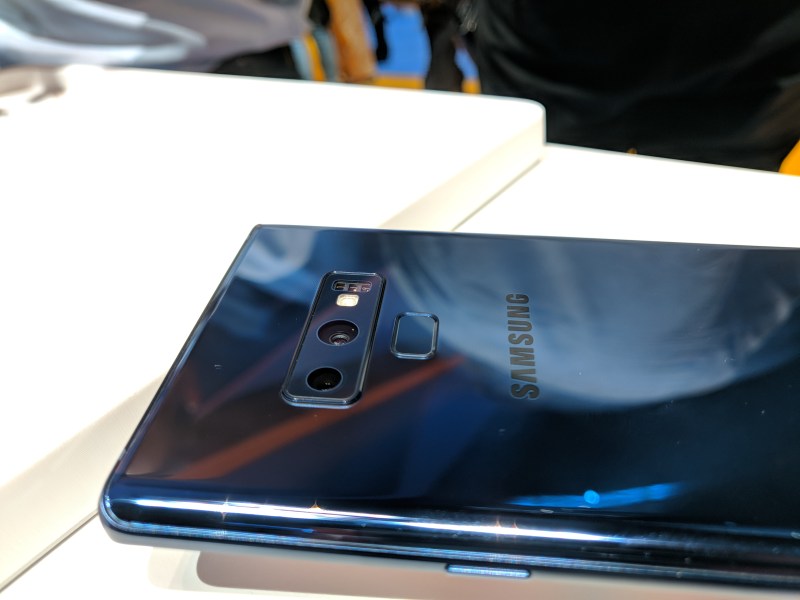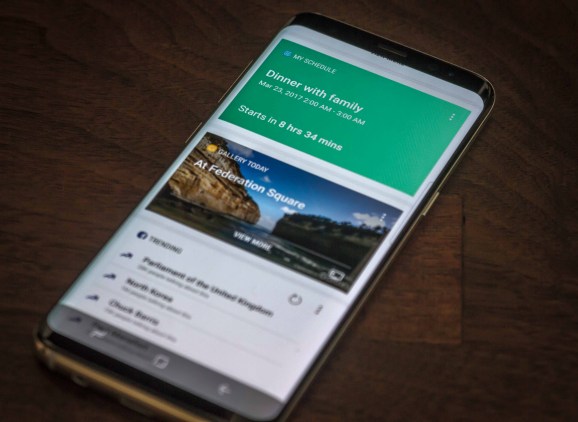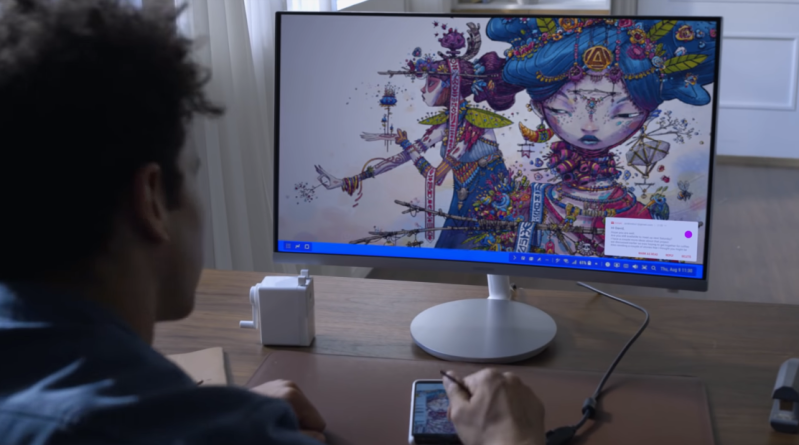After months of rampant speculation (and plenty of leaks and rumors), it’s finally here: the Samsung Galaxy Note9, the latest in a long line of stylus-touting flagship smartphones from the Korean company. (Also now official: the Galaxy Watch and Galaxy Home, a smart home speaker.) It’s a tad early for a final verdict — the first units won’t ship until August 24, roughly two weeks after they become available for preorder — but Samsung gave us an idea of what to expect from the smartphone at a lavish event at the Barclays Center in Brooklyn, New York.
Here’s everything you need to know.
Design
The Galaxy Note9 shares a lot in common with the Galaxy Note8, its year-old predecessor. In fact, if you put the two side by side, you’d have a tough time telling them apart.
The Note9’s body is fashioned from durable aluminum, like the Note8’s, which can withstand submersion in pools of water 1.5 meters deep for a full 30 minutes. It’s about 6.4 inches measured diagonally and 8.8 millimeters thick — just 0.06 inches and 0.2mm larger, respectively, than the Note8. And it weighs 201 grams, making it slightly heavier than the 195-gram Note8.
June 5th: The AI Audit in NYC
Join us next week in NYC to engage with top executive leaders, delving into strategies for auditing AI models to ensure fairness, optimal performance, and ethical compliance across diverse organizations. Secure your attendance for this exclusive invite-only event.
The Note9 boasts a bezel-to-bezel screen with an 18:5:9 aspect ratio that curves around the lip of either edge, with protective glass that’s extraordinarily thin and light (Samsung reportedly delayed the Note9’s launch by two weeks to shave 0.5mm off the panel’s thickness). The top and bottom bezels are a tad narrower, in keeping with industry trends, and with the exception of an iris scanner, ambient light sensor, proximity sensor, front-facing camera, and an earpiece that’s been widened to make room for a larger speaker situated above the screen, there’s not much to look at. It’s the definition of minimalist.
The Note9’s Infinity Display dominates its front, and — contrary to early reports — there isn’t an in-display fingerprint sensor underneath. Some publications suggested that Samsung Display, Samsung’s screen division, was prototyping several designs with a Vivo Nex-like biometric scanner embedded beneath the display, but technical limitations apparently put the kibosh on those plans.
Instead, you’ll find the fingerprint sensor around back and beneath the Note9’s horizontally oriented dual cameras and LED flash, along with a health sensor that measures biometrics like heart rate, blood oxygen, and blood pressure. (That arrangement’s an arguable improvement on the Galaxy Note8’s right-of-camera sensor placement, which made smudging its cameras with a wayward digit frustratingly easy.)
On to the sides: You won’t find any surprises on the Note9’s bottom portion, which houses a USB Type-C port, a microphone, 3.5mm headphone jack, a loudspeaker, and a hollowed-out slot for the S-Pen. The loudspeaker works in tandem with the earpiece to deliver stereo sound; it’s tuned by AKG Acoustics and supports Dolby’s Atmos 3D simulated surround sound technology in supported apps like Netflix. On the left is a power button and volume rocker, and featured prominently on the right is the Bixby key, a button that triggers Samsung’s homegrown AI assistant.
Specifications
The Note series has long been a showcase for bleeding edge, top-of-the-line technology, and the Note9 continues in that tradition.
The 6.4-inch Super AMOLED+ screen is a bona fide stunner. It’s got a Quad HD+ resolution (2,560 x 1,440 pixels; 516 pixels per inch) and a super-bright panel that’s about 10 percent brighter than that of the Galaxy S9 and S9+. That’s impressive — Samsung previously declared the two phones’ 700 nit screens the “brightest ever” on a Galaxy series.
Just like the Galaxy S9 and S9+ before it, the Note9’s panel is certified by the UHD Alliance for Mobile HDR (High Dynamic Range) Premium content. (Without getting into the weeds, HDR videos and video games have a wider color gamut and brightness range, contributing to a picture that’s not only more accurate, but more visually pleasing.) And the phone’s software — specifically Samsung’s Software Video Enhancer — takes full advantage of the screen’s improvements by, when enabled, automatically boosting the illumination and color contrast of steaming and local video.
The beating silicon at the heart of the Note9 is either Samsung’s Exynos 9810 or Qualcomm’s Snapdragon 845 (depending on region), both of which are cooled by a custom-designed water cooling system. (North America, Latin America, Honk Kong, China, and Japan will get the Snapdragon model; the rest of the world will get the Exynos.)
The Exynos 9810, the second in Samsung’s Exynos 9 series, is an eight-core chip consisting of four 2.7GHz high-performance cores and four slightly slower, power-efficient ARM Cortex-A55 cores clocked at 1.7GHz. It packs quite a performance punch, delivering up to 2 times the raw processing power of the Note8’s Exynos 8895 in terms of single-core performance and up to 40 percent in multi-core workloads.
The Qualcomm Snapdragon 845 similarly sports eight cores — four Cortex-A75 performance cores and four efficiency cores. It’s 30 percent faster than the Note8’s Snapdragon 835, overall, and its graphics chip — the Adreno 630 — has 2.5 times the display throughput.
Both the Exynos 9810 and Snapdragon 845 boast modems that deliver download speeds over LTE up to 1.2Gbps (Cat. 18) and custom-designed chips that accelerate machine learning tasks. And both are paired with either 6GB or 8GB of RAM, depending on the model.
On the power front, the Note9’s battery is slightly upgraded from the Note8’s — it’s 4,000mAh compared to the latter’s 700mAh. It supports both Samsung’s Fast Wireless Charging and Adaptive Fast Charging tech, and lasts about a day and a half off a charge.
Last, but not least, storage: The Note9 comes in 64GB and 512GB configurations, both of which have a microSD slot that supports cards up to 512GB.
Bluetooth S Pen
Samsung’s fond of defending the Note lineup‘s styluses — and with good reason. It claims that 92 percent of Note8 owners are active S Pen users, and that a majority — 60 percent — use the S Pen to quickly jot down lists and notes. It doesn’t come as much of a surprise, then, that the Galaxy Note9 ships with a stylus. What is surprising is just how much it has changed from last year’s model.
The Note9 S Pen’s sleek exterior belies its technological improvements. It has 4,096 pressure levels and packs a Bluetooth modem (powered by a tiny battery), which pairs it to the Samsung Galaxy Note9 for neat tricks, like unlocking the phone, manipulating slideshows, pulling double duty as a camera shutter button, controlling music playback, and even serving as a makeshift controller in games like Fortnite. (A software developer kit will allow third parties to tap into it for other functions.) Samsung said it’ll last around 200 clicks of the button on a single charge, and thankfully there’s no awkward charging procedure involved — the S Pen draws power when it’s docked in the Note9’s socket and lasts 30 minutes after just 40 seconds of charging.

Otherwise, the S Pen supports the range of Note features users know and love, like Live Drawings, which lets you sketch or write handwritten messages on photos and backgrounds and send them as GIFs to anyone in your contact list. (The Note9 features exclusive new backgrounds, ink styles, and the option to export the GIFs as MP4 video.)
Also on tap is Screen-off Memo, a digital sketchpad that lets you scribble notes on the Galaxy Note9’s always-on screen without having to unlock it first. As with the Galaxy Note8, you can flick to a new page if you run out of space and pin notes of your choice to the screen for easy access. (A cute touch worth noting: The color of your S Pen corresponds to the color of the text.)
Rounding out the Note9’s bevy of S Pen tools are Translate, which automatically translates words and phrases as you hover over them with the S Pen’s tip; Magnify, which, as the name implies, enlarges parts of the screen; and Smart Select, which lets you crop out a portion of the Note9’s screen and save it as a snapshot.
Cameras and iris scanner
A Bluetooth S Pen and zippy processors aren’t all that’s new in the Note9. There’s an improved pair of cameras on the back — cameras that share nearly the same specifications, not coincidentally, as those in the Galaxy S9.
The cameras comprising the dual rear camera model — one of which has a telephoto lens that delivers up to 2x optical zoom and 10x digital zoom — are both 12MP. But the wide-angle lens has a variable aperture: A tiny contracting and expanding motor embedded in the Note9’s camera module affords you the freedom to switch between f/1.5, a lower aperture better suited to dim lighting, and 2/4, the default setting.

The camera app’s set-it-and-forget-it Automatic mode flips to the f/1.5 aperture automatically when the ambient lighting dips below 100 lux. And a new AI-powered scene detection optimizes color settings like contrast, white balance, exposure, and more based on landscapes, people, animals, or objects in frame. (Handy speech bubbles let you know if someone blinked during a snapshot or if your hand was a bit wobbly.)
Also new on the camera front: improved optical image stabilization; Super Speed Dual Pixel, a faster and more accurate version of Samsung’s Dual Pixel focusing technology; and multiframe noise reduction, which improves the crispness of images by capturing a 12-image burst shot, dividing it into three sets of four, and generating a composite image.
The front-facing camera, meanwhile, is 8MP with an f/1.7 aperture. Courtesy of the Note9’s camera app, it can approximate bokeh — a blurred background and in-focus foreground — in software, taking a page from the Google Pixel and iPhone X’s portrait modes.
When it comes to video, the Note9 can record clips at 4K. Super Slow Motion is present and accounted for — the Note9 shoots clips up to a blistering 960 frames per second (completed automatically if you enable Automatic Capture, which triggers recording when an object enters a definable bounding box) — as is a GIF generator that converts Super Slow Motion videos into shareable images with effects like an Instagram-esque Sing, Loop, and Reverse.
So how about the iris scanner? Well, it’s not much different from the Note8’s camera sensor, with a notable exception: It takes advantage of Intelligent Scan, which uses both the iris scanner and front-facing camera to secure the phone.
Bixby, Fortnite, Spotify, and software
Remember Bixby, Samsung’s answer to digital assistants like Apple’s Siri, the Google Assistant, and Microsoft’s Cortana? It’s back as part of Samsung’s Android 8.1 Oreo-based Software Experience 9.5, and it has a few new tricks up its sleeve.
Bixby 2.0 — the next-gen version of Bixby that Samsung previewed at Mobile World Congress 2018 in March — is all about third-party integrations. It marks the public launch of the Bixby Developer Program, a suite of tools that give third-party app developers greater control and customization over the way Bixby interacts with in-app interfaces. And it sets the stage for deep integration of Viv, the technology platform Samsung acquired in 2016.
Bixby already works with apps like CNN, Flipboard, Facebook, Twitter, and Uber. In the very near future, expect the number of supported apps to grow by leaps and bounds.
The improved Bixby also has better natural language processing, faster response times, and built-in noise reduction tech. Simply put, it should be able to understand you better.
Finally, it’s more conversational — when you ask it about upcoming concerts over Labor Day weekend, for example, it’ll remember that date range when looking for tickets in the future. It knows your preferences, too — when you ask Bixby to book a restaurant, it’ll infer the size of your party and the time based on past reservations.

Above: Bixby Home on the Samsung Galaxy S8.
Otherwise, Bixby Voice works just as it does on the Note8 — Say, “Hey, Bixby” or hold down the Bixby key to prime it for commands like “What’s the weather forecast?” and “Call John.” It supports more than 3,000 commands in all, Samsung said, including chained instructions like “Open the gallery app in split-screen view and rotate misaligned photos” and “Play videos on a nearby TV.”
Bixby retains all its previously announced features, of course, like Bixby Vision. Thanks to integrations with Vivino, Amazon, Nordstrom, Sephora, Cover Girl, and others (and Samsung’s data-sharing partnerships with FourSquare and Pinterest), it can scan barcodes and show relevant product listings, recommend wine, display the calorie counts of food, and let you virtually “try on” makeup products. (One new feature of note: Adobe’s document scanning technology, which turns receipts into readable files, baked in.)
Also on tap is Bixby Home, a “social stream for your device.” It’s a dashboard of reminders and social media updates collated in cards that can be dismissed, pinned, or permanently hidden.
If the new Bixby features don’t excite you, maybe Fortnite will. Epic Games’ hit battle royale title makes its Android debut exclusively on the Note9 (and other Galaxy smartphones), and according to Epic Games’ CEO Tim Sweeney, it won’t come to other Android devices until later this year. To sweeten the pot, Epic’s offering free skins and 15,000 V-Bucks, Fortnite’s virtual currency, to players who preorder the Note9. (That equates to about $150.)
AR Emoji, Samsung’s riff on Apple’s Animoji, debuted on the Galaxy S9 and S9+, and they make a triumphant return here. Here’s the gist, if you haven’t heard of them: They’re three-dimensional cartoons that rely on camera-based tracking to mimic the motions of your head, right down to your mouth and eyebrows. The avatars can be customized with filters, accessories, and masks and exported as stickers in a shareable format (MP4).
And finally, Samsung announced a partnership with Spotify that’ll see the streaming service’s apps tied into the Note9’s setup flow, preloaded music app, and Bixby.
DeX and other accessories
No flagship smartphone is complete without accessories, and the Samsung Galaxy Note9 has them in abundance.
First up is a new dual wireless charger — aply named the Wireless Charging Duo — that simultaneously recharges the Note9 and the recently announced Galaxy Watch. It supports Samsung’s fast-charging standard and connects to a wall adapter via USB Type-C, and it starts at $75.
Next up: cases. Lots of cases. There’s a clear view case that lets a portion of the Note9’s screen show through, a rugged case with a kickstand, and an LED case with a customizable grid layout. They’re available in a variety of colors, including (but not limited to) brown, purple, black, and blue.

Above: The new DeX experience on the Galaxy Note9.
Finally, there’s good news on the DeX front: It no longer requires a dock. (DeX, you might recall, extends the Galaxy Note9’s interface to any computer monitor with an HDMI connection.) All you need is a USB Type-C-to-HDMI adapter; connecting it to an external display gets DeX up and running in a jiffy.
Like the Galaxy Tab S4 before it, the Note9 in DeX mode displays a Windows-like interface, replete with resizeable windows, a dedicated taskbar, mouse and keyboard support, and shortcuts to files, the photo gallery, and settings. Samsung teamed up with Microsoft to optimize Office apps (Word, PowerPoint, and Excel) for the interface, and with Epic Games to support Fortnite. Other partners include the New York Times, Deezer, Amazon, TripAdvisor, Citrix, VMWare, and Craigslist. (Smartphone apps run in DeX, but Samsung makes no guarantees that they won’t misbehave.)
Pricing
So, how much will the Sasmung Galaxy Note9 cost you? That depends on which version — and from which carrier — you decide to buy.
- AT&T has the Note9 for $33.34 for 30 months on AT&T Next installment plans, and it’s throwing in a Galaxy Note9, S9, or S9+ free with purchase for a limited time.
- T-Mobile is selling the Note9 for $30 per month and $279 (for the 128GB model) or $529 (for the 512GB model) down through its Equipment Installment Plan. Customers who trade in an eligible Samsung phone will get 50 percent off the Note9 in the form of 24 monthly bill credits.
- On Sprint, the Note starts at $21 per month after a $21 per month credit for the first two months.
- Verizon has the 128GB Note9 for $42 per month for 24 month and the 512GB model for $52 per month. It’s also offering a buy-on-get-one deal on the Note9, Galaxy S9, and S9+.
Unlocked, the base model with 6GB of RAM and 128GB storage starts at $1,000 — about $70 pricier than the Note8, which started at $929. The 512GB model with 8GB of RAM costs significantly more: $1,250.
In the U.S., a grand nets you two color choices: Ocean Blue or Lavender Purple. (Other colors, including Midnight Black, are available elsewhere, according to the announcement, but aren’t listed on the Samsung site.)
If you’re a sucker for bonuses, you can get a pair of AGK I50 Bluetooth headphones (a $300 value) or a Fortnite Galaxy skin with 15,000 V-bucks free with your preorder between August 10 and 23 — or bundle both for an extra $99 on top of the Galaxy Note9’s base price.
Update at 8:35 a.m. PT: An earlier version of this article listed the Galaxy Note9’s price as $950. The actual price is $1,000. We regret the error.




